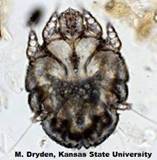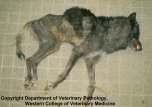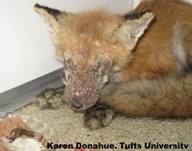| Sarcoptic
Mange |
 |
 |
|
| |
| Causative Agent |
-
Caused by the
mite, Sarcoptes scabiei,
a skin parasite of mammals.
|
| Images |
|
Click on
images to enlarge. |
 |
 |
 |
|
The mage mite,
Sarcoptes scabiei. |
Extensive loss of hair may
occur in severe cases of sarcoptic mange. Mange is commonly
found on wild canids such as this grey wolf. |
Red fox with severe sarcoptic mange. |
|
| Distribution |
|
Geographic: |
-
Found throughout the world.
|
|
Seasonality: |
-
Observed throughout the year, but most commonly observed during winter
months when hair loss can be life-threatening.
|
|
| Hosts, Transmission and Life
Cycle |
| Hosts: |
-
Infections occur in
humans (called "scabies"), wild and domestic dogs and cats,
bears and
mustelids.
-
Sarcoptic mange is commonly found on red fox (Vulpes
vulpes), wolves (Canis
lupus), and coyotes (C.
latrans) in North America. It has been reported to occur
in all three of these species in British Columbia.
-
Mange in wild species predominantly affects younger
animals.
|
|
Transmission and Life Cycle: |
-
Mange is highly
contagious, usually resulting from direct transfer of
mites at
any stage of their development.
-
Indirect transfer of
mites may
also occur from infected inanimate objects
(mechanical transmission).
-
Populations of S. scabiei are usually highly
specific as to their host species; human-adapted populations spread
more rapidly among humans, dog-adapted types spread more
rapidly among dogs, etc.
-
The life cycle of S. scabiei is completed within
burrows in the
epidermis of the host.
-
Adult
mites
mate in small pockets near the surface of the skin.
-
After mating, female
mites
burrow through the skin by chewing and feeding on live cells
or fluid from damaged tissue. Eggs are laid throughout the
tunnel.
-
Hatched larvae pass through a nymphal stage and continue
migration through the
epidermis, becoming adults within 2 weeks of hatching.
-
Mites
can remain infective without a host for extended
periods; an important factor in the maintenance of the
disease.
|
|
| Signs and Symptoms |
| Animals: |
-
Mange infestations are
characterized by oily skin, crusting, hair loss, and scab formation.
-
Infections typically
begin on elbows and towards the tips of the ears, and can eventually
involve large areas of the body.
-
Lesions
result from physical damage to the skin, irritation
caused by parasite excretions, and the immune response of the host.
-
Lesions
may be covered by thick fur, but hair is often lost in
characteristic patterns.
-
Affected skin is itchy and self-trauma may
often be evident.
-
Poor
body condition and listlessness may be observed in severely infected
animals; for example, mangy wild canids (e.g., coyotes) may be
easily approached.
-
Severely affected carnivores may scavenge with increased frequency.
-
Severely affected carnivores may ultimately die from complications
with mange infection or exposure to the elements that results from
hair loss in winter.
|
| Humans: |
-
Lesions
usually occur at sites where contact was made with infected animals
(e.g., hands and arms) and are usually short in duration. As in
animals, skin becomes red,
inflamed and
intensely itchy.
-
Human infections from animal sources are short-lived and
self-limiting.
|
| Meat Edible? |
-
There is no risk to
humans since the meat from canids or other potential carnivore hosts
is not normally consumed.
|
| Human Health Concerns and
Risk Reduction |
-
Rubber gloves and
protective clothing should be worn when handling wildlife with skin
conditions.
-
Applications of
pesticides (acaricides) can be used to treat infected animals and
people; however, repeated applications are necessary.
|
| Samples for Diagnosis |
-
Identification of the
mite from deep skin scrapings or skin
biopsy of
the affected area.
|
| Similar Diseases |
-
Unlike
ticks,
mites causing sarcoptic mange cannot be seen with the naked eye.
|
| Further Reading |
|
|
|
|




